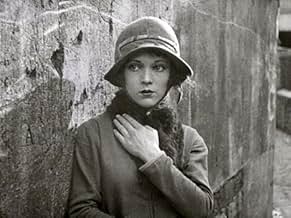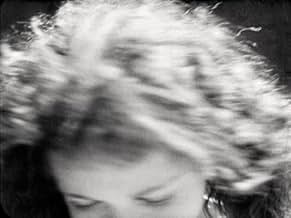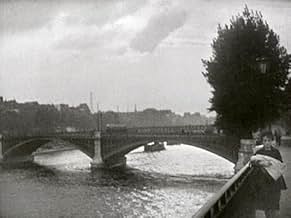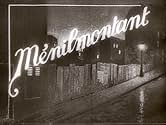Ménilmontant
- 1926
- 38min
NOTE IMDb
7,8/10
2,9 k
MA NOTE
Ajouter une intrigue dans votre langueA couple is brutally murdered in the working-class district of Paris. Later on, the narrative follows the lives of their two daughters, both in love with a Parisian thug and leading them to ... Tout lireA couple is brutally murdered in the working-class district of Paris. Later on, the narrative follows the lives of their two daughters, both in love with a Parisian thug and leading them to separate ways.A couple is brutally murdered in the working-class district of Paris. Later on, the narrative follows the lives of their two daughters, both in love with a Parisian thug and leading them to separate ways.
- Réalisation
- Scénario
- Casting principal
Avis à la une
Dimitri Kirsanoff, born in Estonia but operating mostly in Paris, was heavily influenced by the theories of Soviet Montage. In his most famous short film, 'Ménilmontant (1926)' still frightfully obscure in most circles he adheres to this style strictly, almost obsessively. His preference towards a brisk editing pace carries a unique vitality that is also seen in the work of Soviet masters Eisenstein and Vertov, who pioneered and perfected the technique of montage in the mid-to-late 1920s. But, nevertheless, I don't think it works quite as well here. 'The Battleship Potemkin (1925)' and 'The Man with the Movie Camera (1929) perhaps the two most recognised works of Soviet montage utilise their chosen editing style to full effect precisely because they place greater emphasis on the collective over the individual, in accordance with traditional Communist ideology. There is deliberately no emotional connection attempted nor made between the viewer and any individual movie character, for that would be contrary to the filmmaker's intentions (interestingly, however, the montage fell out of preference from the 1930s in favour of Soviet realism).
'Ménilmontant' falters because it strives to create an emotional connection with the characters (particularly the younger sister, played by Nadia Sibirskaïa), but Kirsanoff's chosen editing style continually keeps the audience at an arm's length. The closest he comes to true pathos is with the park-bench sequence, when an old man offers some bread and meat to the famished woman, delicately avoiding eye contact to preserve her dignity. Even in this scene, the montage style intrudes. A director like Chaplin (and I'm a romantic at heart, so he's naturally one of favourite filmmakers) would have placed the camera at a distance, framing the profiles of both the woman and the old man within the same shot, thus capturing the subtle emotions and inflections of both parties simultaneously. Kirsanoff somewhat confuses the scene, cutting sequentially between the woman, the man and the food in a manner that reduces a simple, poignant act of kindness into a technical exercise in film editing. It works adequately, of course, a precise demonstration of the Kuleshov Effect, but there's relatively little heart in it.
But we'll cease with my complaints hereafter. I know my own film tastes well enough to recognise that what I disliked about the film its emotional distance, for example represents precisely what others love about it. There's no doubting that the photography (when it's kept on screen long enough) is breathtakingly spectacular, making accomplished use of lighting, shadows and in-camera optical effects such as dissolves, irises and superimpositions. There are touches of the surreal. Kirsanoff cuts non-discriminately forwards in time, backwards and into his characters' dreams, fragmenting time and reality into a series of shattered images, their individual meanings obscure until considered sequentially as in the pieces of a puzzle. Most impressive, I thought, was how several shots captured the linear perspective of roads and alleys, watching his characters gradually depart into the distance as though merely following the predetermined pathways of their future. The film ends exactly as it begins with a bloody and unexplained murder suggesting the inevitable cycle of human suffering, its causes unknown and forever incomprehensible.
'Ménilmontant' falters because it strives to create an emotional connection with the characters (particularly the younger sister, played by Nadia Sibirskaïa), but Kirsanoff's chosen editing style continually keeps the audience at an arm's length. The closest he comes to true pathos is with the park-bench sequence, when an old man offers some bread and meat to the famished woman, delicately avoiding eye contact to preserve her dignity. Even in this scene, the montage style intrudes. A director like Chaplin (and I'm a romantic at heart, so he's naturally one of favourite filmmakers) would have placed the camera at a distance, framing the profiles of both the woman and the old man within the same shot, thus capturing the subtle emotions and inflections of both parties simultaneously. Kirsanoff somewhat confuses the scene, cutting sequentially between the woman, the man and the food in a manner that reduces a simple, poignant act of kindness into a technical exercise in film editing. It works adequately, of course, a precise demonstration of the Kuleshov Effect, but there's relatively little heart in it.
But we'll cease with my complaints hereafter. I know my own film tastes well enough to recognise that what I disliked about the film its emotional distance, for example represents precisely what others love about it. There's no doubting that the photography (when it's kept on screen long enough) is breathtakingly spectacular, making accomplished use of lighting, shadows and in-camera optical effects such as dissolves, irises and superimpositions. There are touches of the surreal. Kirsanoff cuts non-discriminately forwards in time, backwards and into his characters' dreams, fragmenting time and reality into a series of shattered images, their individual meanings obscure until considered sequentially as in the pieces of a puzzle. Most impressive, I thought, was how several shots captured the linear perspective of roads and alleys, watching his characters gradually depart into the distance as though merely following the predetermined pathways of their future. The film ends exactly as it begins with a bloody and unexplained murder suggesting the inevitable cycle of human suffering, its causes unknown and forever incomprehensible.
The Ménilmontant depicted here by Dimitri Kirsanofff is a far cry from the picturesque village of Charles Trenet's famous chanson. The grim and narrow cobbled streets provide a backdrop for a film of which the subject matter is that of conventional melodrama but which has been raised by Dimitri Kirsanoff to the level of cinematic art.
The stylistic effects he employs are those of Impressionism, notably rapid montage, superimposition and flashbacks but never at the expense of the narrative and nigh-on a century later the film's emotive power has not diminished and remains a devastating piece of social realism which concerns two orphaned sisters who are eventually reconciled, having been betrayed by the same man.
Suffice to say the lynchpin is the director's wife and muse Nadia Sibirskaia whose face is adored by the camera and whose performance as the younger sister is stunning in its simplicity.
The mood of the film is heightened by the newly composed score of the talented Paul Mercer.
This is the second and indeed oldest surviving film of Russian émigré Kirsanoff and although to my knowledge he never again reached such heights this piece of ciné poetry guarantees his immortality.
The stylistic effects he employs are those of Impressionism, notably rapid montage, superimposition and flashbacks but never at the expense of the narrative and nigh-on a century later the film's emotive power has not diminished and remains a devastating piece of social realism which concerns two orphaned sisters who are eventually reconciled, having been betrayed by the same man.
Suffice to say the lynchpin is the director's wife and muse Nadia Sibirskaia whose face is adored by the camera and whose performance as the younger sister is stunning in its simplicity.
The mood of the film is heightened by the newly composed score of the talented Paul Mercer.
This is the second and indeed oldest surviving film of Russian émigré Kirsanoff and although to my knowledge he never again reached such heights this piece of ciné poetry guarantees his immortality.
Dmitri Kirsinov's Menilmontant is considered to be a landmark in the art of film-making. The story is sparse, melodramatic, and brief. The film is barely twenty minutes long. A young girl leaves home after a somewhat vague hatchet murder takes place. She spends time in the seedy streets of Menilmontant, a medieval suburb of Paris. She drifts through a relationship with her sister and man friend.
If you are looking for a strong story and character development, you may be missing the point. Kirsanov was trying to manipulate images in such a way as to get a reaction from his viewer. The bigger story is just a convention on which to hang his moody images. The axe murder with its choppy editing is a very early use of this sort of emotive technique. You are one moment under the flailing axe, interleaved with fast cuts of a howling victim. Later in the film the younger sister is the center of a blurry sensual reverie, her body and her grim surroundings in and out of focus. Silent film as art needs to be taken on its own terms. Kirsanov and other early filmmakers helped to define the way we view, and how we understand the film narrative. That understanding of how the film story works was established quite some time ago, which needs remembering by those of us not around in 1926. It was not foreordained that fast editing, double exposure and other techniques would come into their own. Someone had to prove the power of a restrained use of these formal ideas. Kirsanov did this in 1926.
If you are looking for a strong story and character development, you may be missing the point. Kirsanov was trying to manipulate images in such a way as to get a reaction from his viewer. The bigger story is just a convention on which to hang his moody images. The axe murder with its choppy editing is a very early use of this sort of emotive technique. You are one moment under the flailing axe, interleaved with fast cuts of a howling victim. Later in the film the younger sister is the center of a blurry sensual reverie, her body and her grim surroundings in and out of focus. Silent film as art needs to be taken on its own terms. Kirsanov and other early filmmakers helped to define the way we view, and how we understand the film narrative. That understanding of how the film story works was established quite some time ago, which needs remembering by those of us not around in 1926. It was not foreordained that fast editing, double exposure and other techniques would come into their own. Someone had to prove the power of a restrained use of these formal ideas. Kirsanov did this in 1926.
Watched Dimitri Kirsanoff's Ménilmontant last night. It's right out of the top drawer. Filmed in 1926 when the rubric for making a film was not yet set, the rules not there to be broken. You can sense the sheer vitality that the filmmaker is enabled with because of this. It feels like a Zola novel, a great portrait of urban life, and also a valuable document of the way Paris looked at the time. Kirsanoff is not weighed down by cinematic antecedents, there are no Hitchockian homages, no cinematic in-jokes, no nods to popular culture, no product placement. This makes the film alive with atmosphere, almost overflowing with it. Somehow Mr Kirsanoff places you in the film, makes you an insider to the innocence of childhood, the loneliness of the big city, the despair of poverty, the shock of betrayal.
His camera is like the Kino-Eye, and it looks at things the way real people look at them, making it the least phallic use of a camera that I have seen. The shots of the Seine, of the countryside, of Ménilmontant, and the roving, lingering, pace of the camera were quite literally breath-taking. There are no intertitles in this silent movie, and the plot is a little opaque, but really this is not taking the movie on its own terms, it is a masterpiece of camera-work and editing and provides the most atmosphere of any movie I have ever seen. It is ESSENTIAL to watch this movie at its 38 minute pace. I saw it on the double-disc Kino edition of Avant-garde: Experimental Cinema of the 1920s and 30s. This is the best value for money DVD on the market full stop.
Recently I watched Lang's The Testament of Dr Mabuse and became aware through his virtuosic use of sound, how taken for granted sound is in movies these days. Watching Ménilmontant makes you realise how taken for granted image is, most of modern cinema is simply about dubious storytelling to quote something I heard on TV, " it's a cultural wasteland filled with inappropriate metaphors and an unrealistic portrayal of life created by the liberal media elite". I recommend this movie to all lovers of cinema, it really is a movie that can make you once again enthuse about the moving image.
His camera is like the Kino-Eye, and it looks at things the way real people look at them, making it the least phallic use of a camera that I have seen. The shots of the Seine, of the countryside, of Ménilmontant, and the roving, lingering, pace of the camera were quite literally breath-taking. There are no intertitles in this silent movie, and the plot is a little opaque, but really this is not taking the movie on its own terms, it is a masterpiece of camera-work and editing and provides the most atmosphere of any movie I have ever seen. It is ESSENTIAL to watch this movie at its 38 minute pace. I saw it on the double-disc Kino edition of Avant-garde: Experimental Cinema of the 1920s and 30s. This is the best value for money DVD on the market full stop.
Recently I watched Lang's The Testament of Dr Mabuse and became aware through his virtuosic use of sound, how taken for granted sound is in movies these days. Watching Ménilmontant makes you realise how taken for granted image is, most of modern cinema is simply about dubious storytelling to quote something I heard on TV, " it's a cultural wasteland filled with inappropriate metaphors and an unrealistic portrayal of life created by the liberal media elite". I recommend this movie to all lovers of cinema, it really is a movie that can make you once again enthuse about the moving image.
This is one that no one can afford to miss in a lifetime of viewing, that is no one who's interested in the deepest workings of how things move. In my third viewing now, it may just be the pinnacle of the first 30 years. But before saying more, let's quickly clear the air from fixed perceptions so it can rise up in front of us vibrantly as what it is, all the more greater.
First to reclaim it from the museum of merely academic appreciation that covers, silents in particular, with the shroud of musky relic. Coming to us from so far back it may appear as the studied work of a venerable master - and yet it's the work of a 25 year old (filming started in '24) who shot it by himself with his girl around Paris, hand-held, and edited in camera.
The workings of fate or grande history that demand crowds and decor are pushed to the side, this is a youthful cinema ("indie" we would call it now) that beats with the heart of young people trying to fathom life in the complex city and I urge you see it as such. Kirsanov was an émigré new to Paris after all. Watch it as puzzling modern life that keeps you awake at nights, not as some scholar's symbolism.
Then to reclaim it from the clutches of "experimental" and "avant- garde", labels as though it were just about the tweaking of form, an exercise of trying to be ahead of time. There are many of those from the era, marvelous experiments in seeing, and Kirsanov was not just a wide-eyed country boy - he had articles published on "photogenie" before he made this and would know the radical tropes. But this enters beyond.
The best way I find myself able to describe it is this.
There's a story here that you can unfold in a way that it makes simple sense, melodrama about an orphaned girl lost in the big city. Melodrama since well before of course, offered us a certain facsimile of life where this clearly begat that, the disparity caused grief, the resolutions restored clarity. There's a heart breaking scene here on a bench worthy of Chaplin. She wanders with a baby cradled in her arms, trials and tribulations that innocence must go through.
Now this facsimile rippled and violently tossed about like curtains at an open window are shuffled by gusts of air, ellipsis, abstraction, rapid-fire montage, and all the other tools that Kirsanov would have known from being in Paris at the time of Epstein and others. So far so good. The film would have been great with just this mode, wholly visual, "experimental". The girl Nadia is lovely, the air dreamlike.
But there's something else he does, that is still in the process of being fathomed decades later by penetrative thinkers like Lynch. There are hidden machinations in the world of the film, illogical machinery at play, that turn at a level deeper than we can clearly fathom at any point. You should know here that Kirsanov had to cross a Europe collapsing by war and revolutions to reach Paris, he would have found out months after he left home that his father had been murdered on the street by communist thugs.
Suddenly there is the nagging sense of a presence that moves behind appearances, giving rise to mysteriously connected perturbations. A marvelous sequence shows one sister being seduced in a room (uncertain, but giving in), the other sister alone in their bed reading from a book as if daydreaming the whole dalliance.
And then the second sister knowingly letting herself be seduced, the first observing the scene from below as if she has splintered off into separate selves, one being seduced above, the other realizing in hallucinative daydream the mistake of giving herself to this boy.
This is marvelous. Impulses from an open window, and through the flimsy fabric of the curtains, the vague coming and going of people in a room, half-finished glimpses, but we begin to sense pattern here. Two girls, two murders, two seductions, but one calculated and wrong.
The most startling moment is the opening; a puzzling violence has stolen into this world, creating the story, rendered with haunting imagery of a struggle before a window. Now every account of the film I've read believes these are the parents of the girls and some madman, but this is not said anywhere. In the graveyard after, we see the father's grave with wreaths, a funeral that day, but none on the mother's, it looks abandoned. Maybe someone was caught where he shouldn't have been, calculated and wrong.
And this veiled and bubbling causality goes through everything to appear again in the finale; the first murder wasn't random, what says the second is? Maybe a holdup just so happened to visit him, maybe someone was paid off. The door is open, you go in where your body takes you.
Something to meditate upon
First to reclaim it from the museum of merely academic appreciation that covers, silents in particular, with the shroud of musky relic. Coming to us from so far back it may appear as the studied work of a venerable master - and yet it's the work of a 25 year old (filming started in '24) who shot it by himself with his girl around Paris, hand-held, and edited in camera.
The workings of fate or grande history that demand crowds and decor are pushed to the side, this is a youthful cinema ("indie" we would call it now) that beats with the heart of young people trying to fathom life in the complex city and I urge you see it as such. Kirsanov was an émigré new to Paris after all. Watch it as puzzling modern life that keeps you awake at nights, not as some scholar's symbolism.
Then to reclaim it from the clutches of "experimental" and "avant- garde", labels as though it were just about the tweaking of form, an exercise of trying to be ahead of time. There are many of those from the era, marvelous experiments in seeing, and Kirsanov was not just a wide-eyed country boy - he had articles published on "photogenie" before he made this and would know the radical tropes. But this enters beyond.
The best way I find myself able to describe it is this.
There's a story here that you can unfold in a way that it makes simple sense, melodrama about an orphaned girl lost in the big city. Melodrama since well before of course, offered us a certain facsimile of life where this clearly begat that, the disparity caused grief, the resolutions restored clarity. There's a heart breaking scene here on a bench worthy of Chaplin. She wanders with a baby cradled in her arms, trials and tribulations that innocence must go through.
Now this facsimile rippled and violently tossed about like curtains at an open window are shuffled by gusts of air, ellipsis, abstraction, rapid-fire montage, and all the other tools that Kirsanov would have known from being in Paris at the time of Epstein and others. So far so good. The film would have been great with just this mode, wholly visual, "experimental". The girl Nadia is lovely, the air dreamlike.
But there's something else he does, that is still in the process of being fathomed decades later by penetrative thinkers like Lynch. There are hidden machinations in the world of the film, illogical machinery at play, that turn at a level deeper than we can clearly fathom at any point. You should know here that Kirsanov had to cross a Europe collapsing by war and revolutions to reach Paris, he would have found out months after he left home that his father had been murdered on the street by communist thugs.
Suddenly there is the nagging sense of a presence that moves behind appearances, giving rise to mysteriously connected perturbations. A marvelous sequence shows one sister being seduced in a room (uncertain, but giving in), the other sister alone in their bed reading from a book as if daydreaming the whole dalliance.
And then the second sister knowingly letting herself be seduced, the first observing the scene from below as if she has splintered off into separate selves, one being seduced above, the other realizing in hallucinative daydream the mistake of giving herself to this boy.
This is marvelous. Impulses from an open window, and through the flimsy fabric of the curtains, the vague coming and going of people in a room, half-finished glimpses, but we begin to sense pattern here. Two girls, two murders, two seductions, but one calculated and wrong.
The most startling moment is the opening; a puzzling violence has stolen into this world, creating the story, rendered with haunting imagery of a struggle before a window. Now every account of the film I've read believes these are the parents of the girls and some madman, but this is not said anywhere. In the graveyard after, we see the father's grave with wreaths, a funeral that day, but none on the mother's, it looks abandoned. Maybe someone was caught where he shouldn't have been, calculated and wrong.
And this veiled and bubbling causality goes through everything to appear again in the finale; the first murder wasn't random, what says the second is? Maybe a holdup just so happened to visit him, maybe someone was paid off. The door is open, you go in where your body takes you.
Something to meditate upon
Le saviez-vous
- AnecdotesPauline Kael said this was her favorite film of all time.
- Versions alternativesThis film was published in Italy in an DVD anthology entitled "Avanguardia: Cinema sperimentale degli anni '20 e '30", distributed by DNA Srl. The film has been re-edited with the contribution of the film history scholar Riccardo Cusin . This version is also available in streaming on some platforms.
- ConnexionsFeatured in The language of the silent cinema 1895-1929 - Part II: 1926-1929 (1973)
Meilleurs choix
Connectez-vous pour évaluer et suivre la liste de favoris afin de recevoir des recommandations personnalisées
Détails
- Durée38 minutes
- Couleur
- Mixage
- Rapport de forme
- 1.33 : 1
Contribuer à cette page
Suggérer une modification ou ajouter du contenu manquant

Lacune principale
By what name was Ménilmontant (1926) officially released in Canada in English?
Répondre
















